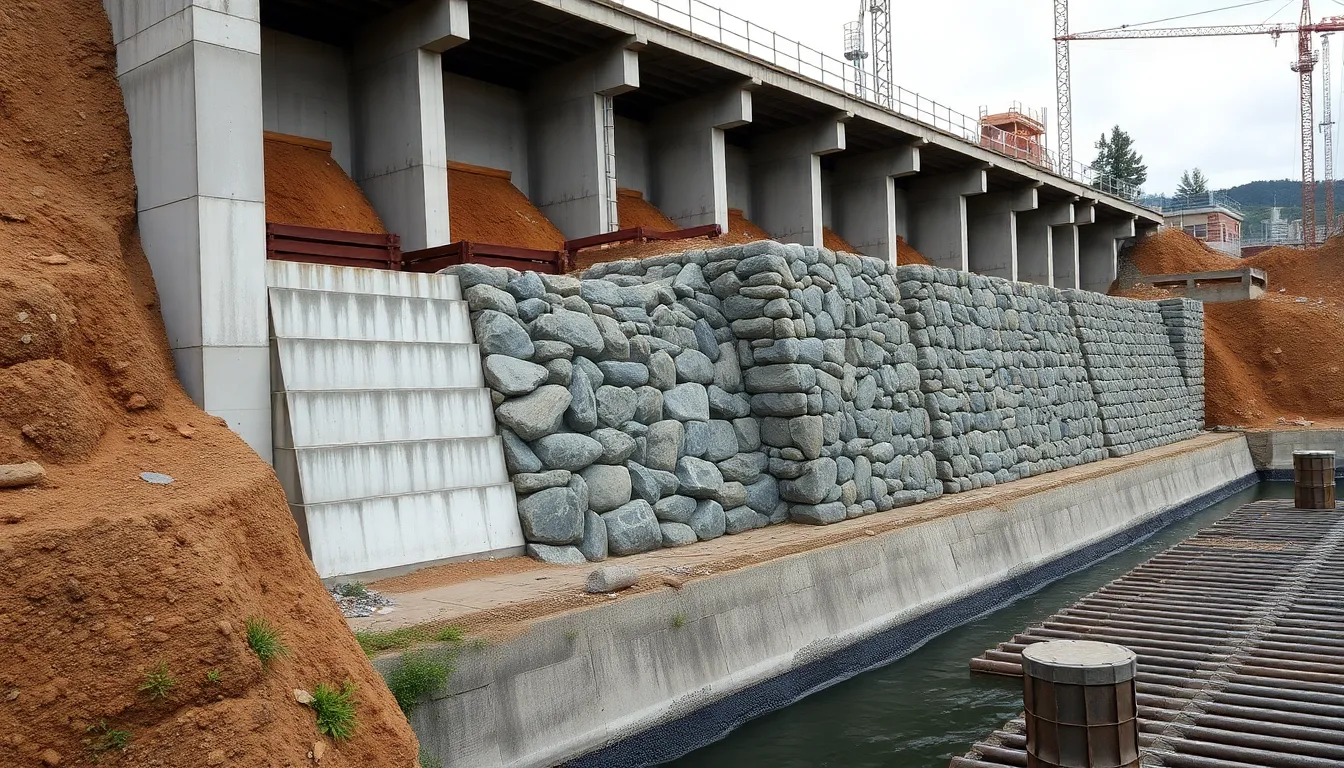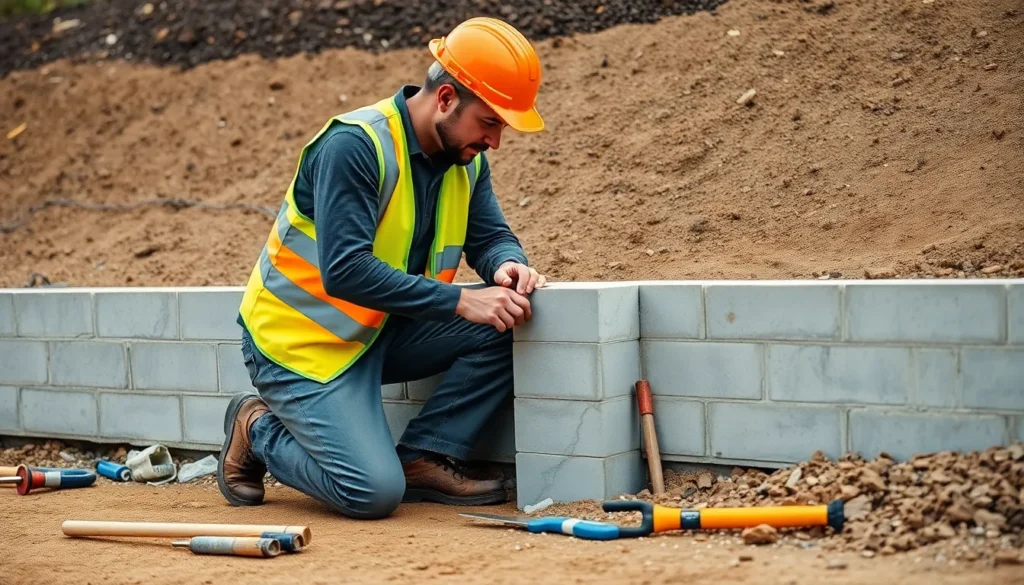Building a retaining wall is more than just a practical solution for managing soil erosion; it’s a blend of art and engineering that enhances the landscape. These structures not only provide stability to sloped terrains but also create visually appealing outdoor spaces. Whether for residential gardens or commercial properties, understanding the intricacies of retaining wall construction is essential for achieving long-lasting results.
From selecting the right materials to understanding drainage systems, effective construction techniques play a crucial role in the wall’s durability. As homeowners and builders explore options, they’ll find various designs and styles that cater to both functionality and aesthetics. With the right knowledge, anyone can transform their outdoor areas while ensuring safety and stability.
Table of Contents
ToggleOverview of Retaining Wall Construction
Retaining wall construction involves several critical steps to ensure functionality and longevity. Proper planning and site assessment precede the actual construction phase. During this stage, builders evaluate soil type, slope grade, and water drainage to determine the most effective design.
Material Selection
Material choice significantly impacts the durability and aesthetic appeal of retaining walls. Common materials include:
- Concrete Blocks: Versatile and durable, concrete blocks offer strength and a variety of designs.
- Natural Stone: Provides an authentic look, though it may require more labor and expertise during installation.
- Timber: Cost-effective and easy to work with, timber suits smaller walls but may have a shorter lifespan than stone or concrete.
Construction Techniques
Various construction techniques cater to specific needs and designs. Key methods include:
- Gravity Walls: Rely on their weight to resist soil pressure. Suitable for shorter walls.
- Cantilever Walls: Utilize concrete slabs to transfer load to the base. Ideal for medium to tall walls.
- Anchored Walls: Incorporate anchors to enhance stability, effective for high structures in unstable soils.
Drainage Systems
Effective drainage systems prevent water accumulation behind the wall, which can lead to structural failure. Essential components of drainage systems include:
- Weep Holes: Allow water to escape, reducing hydrostatic pressure.
- Drain Pipes: Direct water away from the wall, ensuring long-term stability.
- Gravel Backfill: Facilitates proper drainage, preventing soil erosion behind the wall.
Design and Aesthetics
Retaining walls can enhance visual appeal when designed thoughtfully. Incorporating landscaping elements, such as:
- Plants: Integrate vegetation to soften hard surfaces and improve aesthetics.
- Lighting: Use outdoor lighting to highlight the wall’s features at night.
- Color and Texture: Choose color schemes and textures that complement surrounding architecture.
By considering these elements, builders create functional and visually appealing retaining walls that withstand the test of time.
Types of Retaining Walls

Different types of retaining walls serve unique functions in construction. Understanding these types helps in selecting the best option for specific needs.
Gravity Walls
Gravity walls rely on their weight to resist soil pressure. Typically constructed from concrete or stone, these walls require thick bases to counteract lateral forces. The design allows for the wall’s mass to prevent soil movement effectively. Common uses include terracing and creating flat surfaces on sloped terrain.
Cantilever Walls
Cantilever walls feature a L-shaped design, consisting of a vertical stem and a horizontal base, which provides stability through leverage. These walls require less material compared to gravity walls while maintaining strength. They often utilize reinforced concrete and suit situations where the height exceeds four feet, allowing them to support substantial loads with lesser material usage.
Sheet Pile Walls
Sheet pile walls consist of thin, interlocking sheets driven into the ground. Typically made of steel, vinyl, or wood, these walls efficiently handle lateral earth pressures in areas with limited space. Commonly employed in waterfront projects and places where soil stability is crucial, they offer an effective solution for the management of ground water and soil erosion.
Materials Used in Retaining Wall Construction
Selecting the right materials for retaining wall construction impacts both durability and aesthetics. Three common materials are concrete, stone, and timber, each offering distinct advantages.
Concrete
Concrete serves as a popular choice for its strength and versatility. It’s resistant to weathering and deterioration, making it suitable for various climate conditions. Concrete blocks or poured concrete walls allow for customized shapes and sizes. Additionally, stamped or stained finishes enhance visual appeal, integrating well into outdoor landscapes. When reinforced with steel rebar, concrete walls effectively manage soil pressures.
Stone
Stone provides a natural look and excellent durability. Options like granite, limestone, and slate create visually appealing structures. The interlocking nature of stone promotes stability while allowing for effective drainage. Contractors often select stone for large-scale projects requiring significant support, as it withstands heavy loads well. Incorporating proper mortar techniques can increase the wall’s lifespan and structural integrity.
Timber
Timber offers a cost-effective solution for retaining walls, particularly in smaller projects. Treated wood, such as cedar or redwood, resists decay and insect damage, catering to diverse environmental conditions. Timber walls are relatively easy to install and can be built quickly. However, they may require proper drainage installation, as excessive moisture can compromise wood integrity over time. Still, when designed with care, timber retaining walls can blend beautifully with natural surroundings.
Design Considerations
Designing a retaining wall requires careful consideration of several key factors to ensure both functionality and visual appeal. The following subsections outline critical elements that impact retaining wall construction.
Soil Pressure
Calculating soil pressure remains essential in retaining wall design. The wall must resist lateral loads exerted by the soil, including surcharge loads from nearby structures or vegetation. Engineers typically employ the Rankine or Coulomb theories to estimate soil pressure accurately. They must also account for factors like soil type, which influences cohesion and friction angle. For instance, sandy soils produce different pressure dynamics compared to clayey soils. Using proper design models ensures the wall maintains stability while effectively managing the exerted pressure.
Drainage Solutions
Implementing effective drainage solutions prevents water buildup behind the retaining wall, which can compromise stability and lead to failure. Incorporating weep holes at regular intervals allows groundwater to escape, relieving hydrostatic pressure. Additionally, installing perforated drain pipes behind the wall enables efficient drainage of excess water. Utilizing gravel backfill enhances drainage by facilitating water movement while distributing pressure evenly against the wall. These drainage solutions significantly enhance the longevity and reliability of retaining walls.
Aesthetic Factors
Aesthetic considerations play a vital role in retaining wall design. The choice of materials directly influences the wall’s visual appeal; concrete allows for various textures and colors, while natural stone can provide an organic look. Integrating landscaping elements like plants, lighting, and color schemes enhances the overall environment. Additionally, ensuring the wall blends with existing structures and natural surroundings offers a cohesive appearance. Thoughtful aesthetic design contributes to creating attractive outdoor spaces that fulfill both functional and visual needs.
Common Challenges in Retaining Wall Construction
Retaining wall construction often presents several challenges that can impact effectiveness and durability. Understanding these challenges aids in employing the right strategies for successful project execution.
Erosion Control
Erosion control remains a primary challenge in retaining wall construction. Improperly designed or constructed walls may fail to secure the surrounding soil, leading to instability. Soil erosion caused by water runoff can undermine wall integrity. It’s essential to implement measures like proper backfill placement, which includes aggregates to promote drainage, and vegetation that helps stabilize the soil. Utilizing geo-textiles can also provide additional support, preventing soil movement and reducing erosion risk.
Water Management
Water management is critical in retaining wall construction. Accumulated water behind a wall exerts hydrostatic pressure, compromising structural integrity. Effective drainage systems are necessary to mitigate this pressure. Implementing solutions such as weep holes and drain pipes allows water to escape efficiently. Regular inspections of the drainage system ensure optimal performance. Incorporating a gravel backfill also aids in managing water flow, minimizing water retention and potential damage to the wall over time.
Building a retaining wall involves careful planning and execution to ensure both functionality and aesthetic appeal. By understanding the various construction techniques and selecting appropriate materials, homeowners can create structures that not only prevent soil erosion but also enhance outdoor spaces.
Effective drainage systems play a pivotal role in maintaining the integrity of retaining walls. Regular maintenance and inspections will help mitigate potential issues, ensuring long-lasting stability. With the right approach, retaining walls can serve as both a practical solution and a beautiful addition to any landscape.



